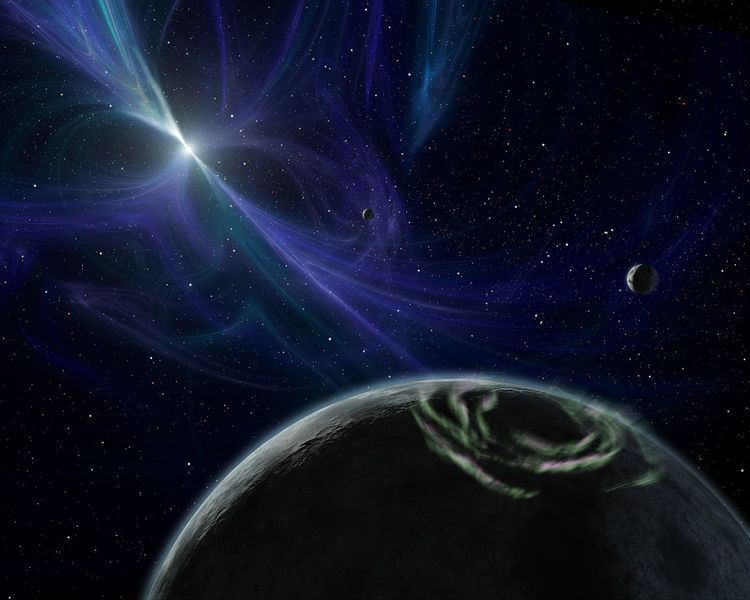Discovery date 22 January 1992 Discovery site Poland | Discovery status Published | |
 | ||
PSR B1257+12 C, alternatively designated PSR B1257+12 d, also named Phobetor, is a super-Earth exoplanet orbiting the pulsar PSR B1257+12 approximately 2,315 light-years (710 parsecs, or nearly 7016219080000000000♠2.1908×1016 km) away from Earth in the constellation of Virgo. It was one of the first planets ever discovered outside the Solar System. It was discovered using the pulsar timing method, where the regular pulses of a pulsar are measured to determine if there is a planet causing variations in the data.
Contents
In July 2014 the International Astronomical Union launched a process for giving proper names to certain exoplanets and their host stars. The process involved public nomination and voting for the new names. In December 2015, the IAU announced the winning name was Phobetor for this planet. The winning name was submitted by the Planetarium Südtirol Alto Adige in Karneid, Italy. Phobetor is the deity of nightmares in Greek mythology.
Mass, radius and temperature
PSR B1257+12 C is a super-Earth, an exoplanet that has a radius and mass larger than that of Earth. It has an equilibrium temperature of 567 K (294 °C; 561 °F). It has a mass of 3.9 M⊕ and a likely radius of 1.5 R⊕, based on its mass.
Host star
The planet orbits a pulsar named PSR B1257+12. The stellar remnant has a mass of 1.4 M☉ and a radius of around 0.000015 R☉ (10 kilometres). It has a surface temperature of ≤28856 K and is one billion years old, with a small margin of error. In comparison, the Sun is about 4.6 billion years old and has a surface temperature of 5778 K.
The star's apparent magnitude, or how bright it appears from Earth's perspective, is 12.2. Therefore, it is too dim to be seen with the naked eye.
Orbit
PSR B1257+12 C orbits its host star with 520% of the Sun's luminosity (5.2 L☉) about every 98 days at a distance of 0.46 AU (close to the orbital distance of Mercury from the Sun, which is 0.38 AU).
Formation
When PSR B1257+12 C and its neighbors were discovered, scientists were puzzled on how the planets formed. Normally, planets orbiting around a massive star would evaporate when its host star exploded in a supernova due to the intense heat (up to 1,000,000 K) and radiation. The discovery of planets around a pulsar were unexpected, considering that a pulsar could be a host to planetary companions.
Several theories have been proposed for how the planets around PSR B1257+12 formed. One theory suggested than the planets actually had existed before the host star exploded in a supernova about 1 billion years ago, however, this is inconsistent as the ejected material from a supernova would be enough to vaporize any planets close to the star. Also, multiple issues arise with this theory that debates nearly-impossible steps on how the planets ended up in their current places. Thus, the scenario has been dropped.
One scenario proposed a massive binary system in which the planets formed around, with the more massive companion exploding in a supernova. The neutron star would then orbit the secondary companion (forming an X-ray binary) until the now-red supergiant exceeded its Roche lobe and began spilling material onto the neutron star, with the transfer being so dramatic that it forms a Thorne–Żytkow object. However this doesn't explain how the pulsar would reach a spin rate of 6 milliseconds, so the model is still being questioned.
Another model stated that the planets might have formed from a fallback disk from the supernova remnant. The main problem is that the resulting pulsar would be a radio pulsar, not the kind of pulsar that PSR B1257+12 is. Thus, it is unlikely that this was how the formed.
The most widely accepted model for the planets around PSR B1257+12 is that they were a result of two white dwarfs merging. The white dwarfs would be in a binary orbit, with the orbit slowly decaying until the lighter white dwarf star filled its Roche lobe. If the mass ratio is large, the lighter companion would be disrupted, forming a disk around the more massive companion. The star would accrete this material, and would result in its mass increasing until it reaches the Chandrasekhar limit, in which it would experience core collapse and turn into a rapidly rotating neutron star, or, to be precise, a pulsar. After the explosion, the disk around the pulsar would still be massive enough (about 0.1 M☉) to form planets, which would likely be terrestrial, due to them being composed of white dwarf material such as carbon and oxygen.
Nomenclature
The convention that arose for designating pulsars was that of using the letters PSR (Pulsating Source of Radio) followed by the pulsar's right ascension and degrees of declination. The modern convention prefixes the older numbers with a B meaning the coordinates are for the 1950.0 epoch. All new pulsars have a J indicating 2000.0 coordinates and also have declination including minutes. Pulsars that were discovered before 1993 tend to retain their B names rather than use their J names, but all pulsars have a J name that provides more precise coordinates of its location in the sky.
On its discovery, the planet was designated PSR 1257+12 C and later PSR B1257+12 C. It was discovered before the convention that extrasolar planets receive designations consisting of the star's name followed by lower-case Roman letters starting from "b" was established. However, it is listed under the latter convention on astronomical databases such as SIMBAD and the Extrasolar Planets Encyclopedia. Hence the alternative designation PSR B1257+12 d.
